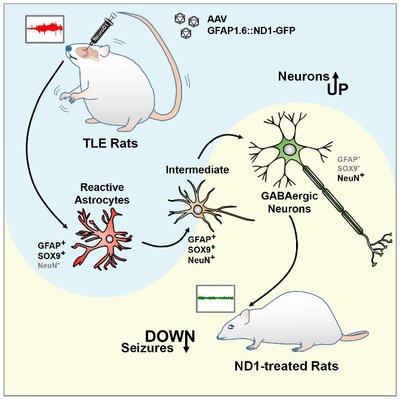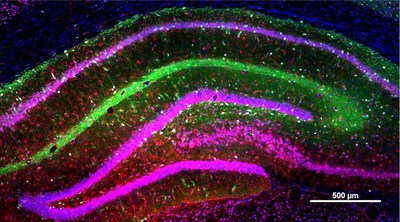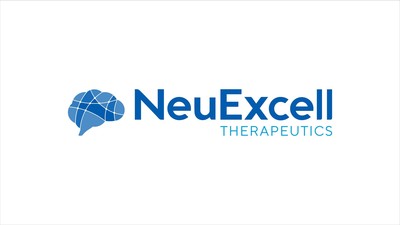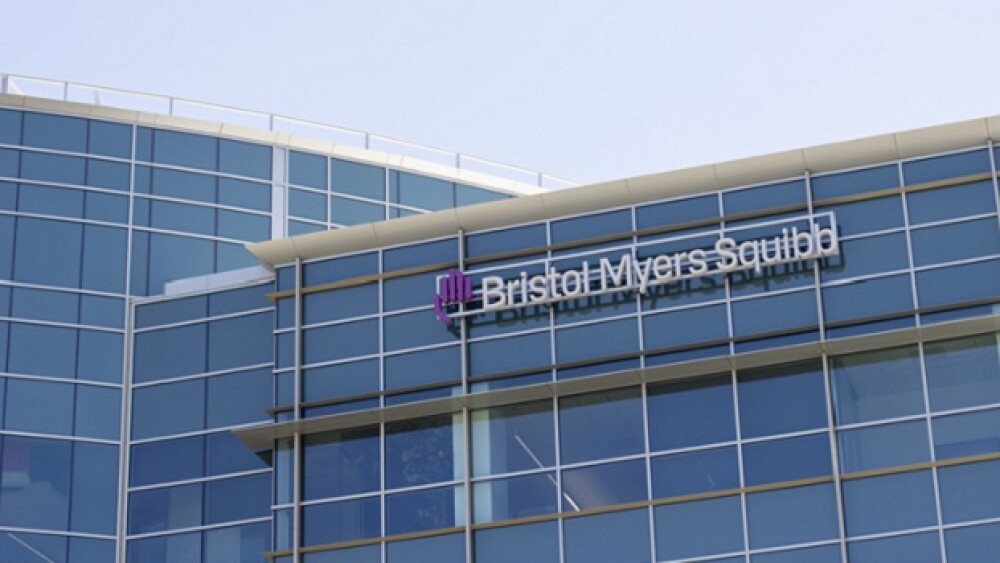A research team led by Professor Gong Chen of Jinan University, also the scientific founder of NeuExcell Therapeutics Group, published an article in the latest issue of Progress in Neurobiology, using neuroregenerative gene therapy to treat temporal lobe epilepsy in rats.
GUANGZHOU, China, Jan. 4, 2022 /PRNewswire/ -- A research team led by Professor Gong Chen of Jinan University, also the scientific founder of NeuExcell Therapeutics Group, published an article in the latest issue of Progress in Neurobiology, using neuroregenerative gene therapy to treat temporal lobe epilepsy (TLE) in rats. Chen's team developed a new technology to convert hippocampal astrocytes directly into inhibitory interneurons and effectively reduced epileptic seizures, raising new hope for patients suffering from refractory TLE.
There are about 50 million epileptic patients worldwide. Current treatment of epilepsy mainly includes anti-epileptic drugs, surgery, and ketogenic diet. About 20%-30% of epileptic patients are not sensitive to anti-epileptic drugs. TLE is a common drug-resistant epilepsy in adults. Its major pathological features include loss of hippocampal interneurons and proliferation of glial cells, which together lead to abnormal excitation of neural network activity. Drug-resistant TLE often requires surgical resection of the diseased hippocampus, which may be associated with certain surgical risks and complications. Other treatments have limited efficacy in controlling TLE. How to treat TLE more effectively without serious brain surgery is a worldwide problem that needs an urgent solution.
In recent years, Chen's team has developed a novel neuroregenerative gene therapy that offers a potential new approach to treat a variety of neurological disorders. Neuroregenerative gene therapy is a new technology that uses viral vectors to deliver neural transcription factors to glial cells in the brain and directly convert glial cells into functional neurons in situ. Based on this innovation, Chen's team has published a series of research articles demonstrating effective brain repair in both ischemic stroke and Huntington's disease animal models.
"In this work, we used adeno-associated virus (AAV) as the gene delivery vector to overexpress a neural transcription factor NeuroD1 specifically in hippocampal astrocytes of TLE rats. NeuroD1 significantly downregulates glial gene expression but upregulates neuronal gene expression, and ultimately converts astrocytes into neurons", said Dr. Jiajun Zheng, the first author of this work, explaining the principle of this work.
"This is the first time we apply neuroregenerative gene therapy to treat epilepsy and achieved success in animal models. One of the highlights in this study is the clear capture of an intermediate state during the conversion of glial cells into neurons. The cells in such an intermediate state bear the properties of both glial cells (GFAP+ or Sox9+) and neurons (NeuN+) and only occur during early conversion stage. These intermediate cells with dual glial and neuronal markers (GFAP+NeuN+ and Sox9+NeuN+) do not exist in normal brains, providing strong evidence of glia-to-neuron conversion under the action of NeuroD1. More importantly, we discovered that cell conversion is highly dependent on NeuroD1 expression level as well as brain regions and animal disease models. For example, strong NeuroD1 expression in cortical astrocytes of stroke mice regenerates excitatory glutamatergic neurons, whereas weak NeuroD1 expression in hippocampal astrocytes of TLE rats regenerates inhibitory GABAergic neurons (although hippocampus has abundant excitatory neurons). This new discovery has important guidance for future clinical applications using neuroregenerative gene therapy to treat different neurological disorders", Professor Chen pointed out the potential clinical significance of this study.
"Our electrophysiological and behavioral analyses demonstrated that the neuroregenerative gene therapy not only inhibited spontaneous recurrent seizures but also rescued the cognitive impairment and mood abnormalities of the epileptic animals. Different from traditional anti-epileptic drugs or surgery treatment, neuroregenerative gene therapy directly regenerates new neurons in the epileptic region to restore the balance between excitation and inhibition in neural networks. This novel technology may lead to a new path toward an effective treatment of drug-resistant epilepsy", the co-corresponding author Jiandong Yu gave an additional note.
In addition to Professor Gong Chen, Associate Professor Jiandong Yu, Dr. Jiajun Zheng, other co-authors include Tingjie Li, Professor Bing Qin and Shuang Qi. This work was funded by the Natural Science Foundation of China (U1801681 and 81671288) and the Science and Technology Department of Guangdong Province (2018B030332001).
Article links:
https://doi.org/10.1016/j.pneurobio.2021.102198
For more information about NeuExcell Therapeutics, please contact:
Lori Gavrin, Ph.D.
Chief Business & Strategy officer
NeuExcell Therapeutics, Inc.
lorigavrin@neuexcell.com
+1-215-668-5442
www.neuexcell.com
![]() View original content to download multimedia:https://www.prnewswire.com/news-releases/neuroregenerative-gene-therapy-treats-temporal-lobe-epilepsy-in-rat-model-301452379.html
View original content to download multimedia:https://www.prnewswire.com/news-releases/neuroregenerative-gene-therapy-treats-temporal-lobe-epilepsy-in-rat-model-301452379.html
SOURCE NeuExcell Therapeutics







